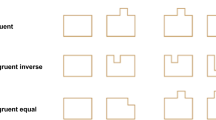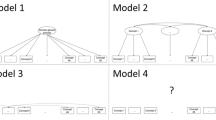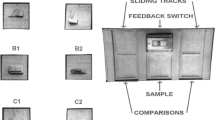Abstract
Recent research efforts have argued for the persistence of some of students’ frequent scientific misconceptions, even after correct answers are produced. Some of these studies, based on the analysis of reaction times, have recorded latencies for counter-intuitive or incongruent stimuli compared to intuitive or congruent ones. The proposed interpretations were that prior knowledge survives learning and still coexists with new closer-to-scientific knowledge, producing conflicts that delay correct answers. But these conclusions are based on the assumption that stimuli from different conditions only differ in the presence/absence of interfering misconceptions, which is sometimes, in our opinion, a rather fragile claim. Thus, we have designed a task in which it is possible to test different levels of interference and not only its effects in contrast to another condition. Then, we have used it to see if different intensities of interference produce different levels of conflict. The task tested the persistence of the misconception that “heavy objects sink more than lighter ones”. One hundred twenty-eight 14- to 15-year-olds were asked to tell which of the 2 balls presented (3 different materials and 3 different sizes) would “sink more” than the other. Analysis verified the presence of latencies and negative priming. For the most part, results show that the intensity of interference does produce corresponding latencies, which suggests greater conflict and therefore supports the hypothesis of persistence and coexistence of conceptions, even after correct answers are produced, and beyond other plausible effects due to the used stimuli. Prescriptions for theory and teaching are proposed.
Article PDF
Similar content being viewed by others
Avoid common mistakes on your manuscript.
References
Aoki, T., Francis, P. R. & Kinoshita, H. (2003). Differences in the abilities of individual fingers during the performance of fast, repetitive tapping movements. Experimental Brain Research, 152(2), 270–280.
Babai, R. & Amsterdamer, A. (2008). The persistance of solid and liquid naive conceptions: A reaction time study. Journal of Science Education and Technology, 17, 553–559.
Babai, R., Eidelman, R. & Stavy, R. (2012). Preactivation of inhibitory control mechanisms hinders intuitive reasoning. International Journal of Science and Mathematics Education, 10, 763–775.
Babai, R., Sekal, R. & Stavy, R. (2010). Persistance of the intuitive conception of living things in adolescence. Journal of Science Education and Technology, 19, 20–26.
Borst, G., Poirel, N., Pineau, A. & Cassoti, M. (2012). Inhibitory control in number-conservation and class-inclusion tasks: A neo-Piagetian inter-task priming study. Cognitive Development, 27(3), 283–298.
Chi, M. (1992). Conceptual change in and across ontological categories: Examples for learning and discovery in science. In R. N. Giere (Ed.), Cognitive models of science (pp. 129–160). Minneapolis, MN: University of Minneapolis Press.
DiSessa, A. A. (2006). A history of conceptual change research. In K. Sawyer (Ed.), Cambridge handbook of the learning sciences (pp. 167–281). Cambridge, UK: Cambridge University Press.
Duit, R. & Treagust, D. (2003). Conceptual change: A powerful framework for improving science teaching and learning. International Journal of Science Education, 25(6), 671–688.
Duit, R., Treagust, D., (2012). Conceptual change: Still a powerful framework for improving science teaching and learning. In K. Shwee, D. Tan and M. Kim (Eds.), Issues and challenges in science education research (pp. 43–55). Berlin, Germany: Springer.
Dunbar, K., Fugelsang, J. & Stein, C. (2007). Do naive theories ever go away? Using brain and behavior to understand changes in concept. In M. C. Lovett & P. Shah (Eds.), Thinking with data: 33rd Carnegie symposium on cognition (pp. 193–206). Mahwah, NJ: Erlbaum.
Egner, T. & Hirsch, J. (2005). Where memory meets attention: Neural substrates of negative priming. Journal of Cognitive Neuroscience, 17(11), 1774–1784.
Evans, S. B. T. (2003). In two minds: Dual-process accounts of reasoning. Trends in Cognitive Sciences, 7(10), 454–459.
Hewson, P. W. (1981). A conceptual change approach to learning science. European Journal of Science Education, 3(4), 383–396.
Hewson, M. (2006). The acquisition of scientific knowledge: Analysis and representation of student conceptions concerning density. Science Education, 70(2), 159–170.
Houdé, O. (2000). Inhibition and cognitive development: Object, number, categorization and reasoning. Cognitive Development, 15, 63–73.
Houdé, O. & Guichart, E. (2001). Negative priming effect after inhibition of number/length interference in a Piaget-like task. Developmental Science, 4, 71–74.
Houdé, O., Pineau, A., Leroux, G., Poirel, N., Perchey, G., Lanoë, C., et al (2011). Functional magnetic resonance imaging study of Piaget’s conservation-of-number task in preschool and school-age children: A neo-Piagetian approach. Journal of Experimental Child Psychology, 110, 332–334.
Houdé, O., Zago, L., Mellet, E., Moutier, S., Pineau, A., Mazoyer, B., et al (2000). Shifting from the perceptual brain to the logical brain: The neural impact of cognitive inhibition training. Journal of Cognitive Neuroscience, 12(5), 721–728.
Hsin, C.-T. & Wu, H.-K. (2011). Using scaffolding strategies to promote young children’s scientific understandings of floating and sinking. Journal of Science Education and Technology, 20(5), 656–666.
Jensen, M. & Finley, F. (1995). Teaching evolution using historical arguments in a conceptual change strategy. Science Education, 79(2), 147–166.
Kelemen, D. & Rosset, E. (2009). The human function compunction: Teleological explanation in adults. Cognition, 111(1), 138–143.
Kelemen, D., Rottman, J. & Seston, R. (2012). Professional physical scientists display tenacious teleological tendencies: Purpose-based reasoning as a cognitive default. Journal of Experimental Psychology 142(4), 1074–1083.
Lafortune, S., Masson, S. & Potvin, P. (2012a). Does inhibition have a key role to play in overcoming intuitive interferences in science? Paper presented at the Neuroscience and education: 2012 meeting of the EARLI SIG 22.
Lafortune, S., Masson, S. & Potvin, P. (2012b). Étude du développement cérébral de la capacité à surmonter des interférences intuitives en sciences. Paper presented at the XVIIe Congrès de l'Association Mondiale des Sciences de l'Éducation (AMSE-AMCE-WAER)- Recherche en éducation et en formation: Enjeux et défis d'aujourd'hui.
Limon, M. (2001). On the cognitive conflict as an instructional strategy for conceptual change: A critical appraisal. Learning and Instruction, 11, 357–380.
Lubin, A., Lanoë, C., Pineau, A. & Rossi, S. (2012). Apprendre à inhiber: Une pédagogie innovante au service des apprentissages scolaires fondamentaux (mathématiques et orthographe) chez des élèves de 6 à 11 ans. Neuroeducation, 1(1), 55–84.
Masson, S., Potvin, P., Riopel, M. & Brault-Foisy, L.-M. (2014). Differences in Brain Activation Between Novices and Experts in Science During a Task Involving a Common Misconception in Electricity. Mind, Brain, and Education, 8(1), 44–55.
Nersessian, N. J. (1998). Model-based reasoning in conceptual change. In L. Magnini, N. J. Nersessian & P. Thagard (Eds.), Model-based reasoning in scientific discovery. New York: Kluwer Academic.
Ohlsson, S. (2009). Resubsumption: A possible mechanism for conceptual change and belief revision. Educational Psychologist, 44(1), 20–40.
Piaget, J. & Cook, M. (1952). The origins of intelligence in children. New York: W.W. Norton and Co.
Potvin, P. (2011). Manuel d'enseignement des sciences et de la technologie: Pour intéresser les élèves du secondaire. Québec: Multimondes.
Potvin, P. (2013). Proposition for improving the classical models of conceptual change based on neuroeducational evidence: Conceptual prevalence. Neuroeducation, 1(2), 16–43.
Potvin, P., Turmel, É. & Masson, S. (2014). Linking neuroscientific research on decision making to the educational context of novice students assigned to a multiple-choice scientific task involving common misconceptions about electrical circuits. Frontiers in Human Neuroscience, 8(14).
Posner, G., Strike, K., Hewson, P. & Gertzog, W. (1982). Accommodation of a scientific conception: Toward a theory of conceptual change. Science Education, 66(2), 211–227.
Rossi, S., Lubin, A., Lanoë, C. & Pineau, A. (2012). Une pédagogie du contrôle cognitif pour l’amélioration de l’attention à la consigne chez l’enfant de 4–5 ans. Neuroeducation, 1(1), 29–54.
Rowell, J. A. & Dawson, C. J. (1977). Teaching about floating and sinking: An attempt to link cognitive psychology with classroom practice. Science Education, 61(2), 243–251.
Schroeder, et al (2007). A meta-analysis of national research: Effects of teaching strategies on student achievement in science in the United States. Journal of Research in Science Teaching, 44(10), 1436–1460.
Shtulman, A. & Valcarel, J. (2012). Scientific knowledge suppresses but does not supplant earlier intuitions. Cognition, 124, 209–215.
Smith, C., Carey, S. & Wiser, M. (1985). On differentiation: A case study of the development of the concepts of size, weight, and density. Cognition, 21(3), 177–237.
Smith, C., Carey, S. & Wiser, M. (1992). Using conceptual models to facilitate conceptual change: The case of weight–density differentiation. Cognition and Instruction, 9(3), 221–283.
Smith, C., Carey, S. & Wiser, M. (1997). Teaching for understanding: A study of students’ preinstruction theories of matter and a comparison of the effectiveness of two approaches to teaching about matter and density. Cognition and Instruction, 15(3), 317–393.
Solomon, J. (1984). Prompts, cues and discrimination: The utilization of two separate knowledge systems. European Journal of Science Education, 6(1), 63–82.
Spada, H. (1994). Conceptual change or multiple representations? Learning and Instruction, 4, 113–116.
Stavy, R. & Tirosh, D. (2000). How students (mis-)understand science and mathematics. New York: Teachers College Press.
Thouin, M. (2001). Notions de culture scientifique et technologique. Concepts de base, percées historiques et conceptions fréquentes. Sainte-Foy, QC: Multimondes.
Tipper, S. P. (1985). The negative priming effect: Inhibitory priming by ignored objects. The Quarterly Journal of Experimental Psychology, 37(4), 571–590.
Tipper, S. P. (2001). Does negative priming reflect inhibitory mechanisms? A review and integration of conflicting views. The Quarterly Journal of Experimental Psychology, 54A(2), 321–343.
Villani, A. (1992). Conceptual change in science and science education. Science Education, 76(2), 223–237.
Yeend, R., Loverude, M. E. & Gonzales, B. (2001). Student understanding of density: A cross-age investigation. Paper presented at the Physics Education Research Conference 2001.
Author information
Authors and Affiliations
Corresponding author
Rights and permissions
Open Access This article is distributed under the terms of the Creative Commons Attribution License which permits any use, distribution, and reproduction in any medium, provided the original author(s) and the source are credited.
About this article
Cite this article
Potvin, P., Masson, S., Lafortune, S. et al. PERSISTENCE OF THE INTUITIVE CONCEPTION THAT HEAVIER OBJECTS SINK MORE: A REACTION TIME STUDY WITH DIFFERENT LEVELS OF INTERFERENCE. Int J of Sci and Math Educ 13, 21–43 (2015). https://doi.org/10.1007/s10763-014-9520-6
Received:
Accepted:
Published:
Issue Date:
DOI: https://doi.org/10.1007/s10763-014-9520-6




